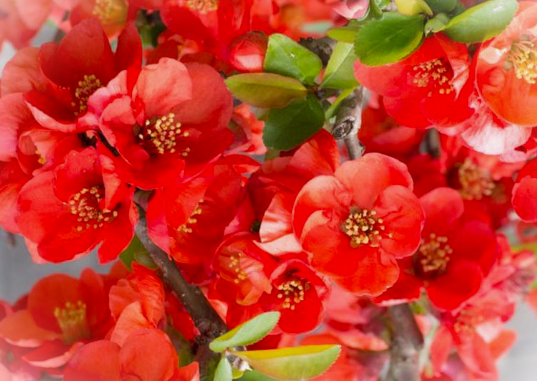Chaenomeles x superba 'Texas Scarlet' (Flowering Quince) 5-gal
‘Texas Scarlet’ is prized as a compact flowering quince, reaching only about 4 ft. tall x 4-5 ft. wide. Other attributes include its abundance of large fiery-red blooms, which persists for many weeks beginning in early spring (before the foliage emerges) and providing nectar sources to native bees, butterflies, and hummingbirds.
As with more flowering quince shrubs, ‘Texas Scarlet’ has a bushy form that creates a habitat thicket and pairs well with broad-leaved evergreen shrubs such as Osmanthus, Arbutus unedo ‘Compacta,’ and Viburnum tinus; it’s a fine addition to a habitat hedgerow or privacy screen.
The abundant flowers become 2-inch fragrant, greenish-yellow quince fruits, ripening in early fall as forage for small mammals and large birds, or to be cooked into jellies or preserves.
‘Texas Scarlet’ flowering quince is highly adaptable and extremely resilient: it grows fine in full sun to part shade; it’s tolerant of tight spacing in hedgerows; it will be successful in just about any soil, including clay, as long as there is adequate drainage; it’s extremely drought tolerant after establishment; and it is resistant to deer and rabbit predation.
‘Texas Scarlet’ is prized as a compact flowering quince, reaching only about 4 ft. tall x 4-5 ft. wide. Other attributes include its abundance of large fiery-red blooms, which persists for many weeks beginning in early spring (before the foliage emerges) and providing nectar sources to native bees, butterflies, and hummingbirds.
As with more flowering quince shrubs, ‘Texas Scarlet’ has a bushy form that creates a habitat thicket and pairs well with broad-leaved evergreen shrubs such as Osmanthus, Arbutus unedo ‘Compacta,’ and Viburnum tinus; it’s a fine addition to a habitat hedgerow or privacy screen.
The abundant flowers become 2-inch fragrant, greenish-yellow quince fruits, ripening in early fall as forage for small mammals and large birds, or to be cooked into jellies or preserves.
‘Texas Scarlet’ flowering quince is highly adaptable and extremely resilient: it grows fine in full sun to part shade; it’s tolerant of tight spacing in hedgerows; it will be successful in just about any soil, including clay, as long as there is adequate drainage; it’s extremely drought tolerant after establishment; and it is resistant to deer and rabbit predation.
‘Texas Scarlet’ is prized as a compact flowering quince, reaching only about 4 ft. tall x 4-5 ft. wide. Other attributes include its abundance of large fiery-red blooms, which persists for many weeks beginning in early spring (before the foliage emerges) and providing nectar sources to native bees, butterflies, and hummingbirds.
As with more flowering quince shrubs, ‘Texas Scarlet’ has a bushy form that creates a habitat thicket and pairs well with broad-leaved evergreen shrubs such as Osmanthus, Arbutus unedo ‘Compacta,’ and Viburnum tinus; it’s a fine addition to a habitat hedgerow or privacy screen.
The abundant flowers become 2-inch fragrant, greenish-yellow quince fruits, ripening in early fall as forage for small mammals and large birds, or to be cooked into jellies or preserves.
‘Texas Scarlet’ flowering quince is highly adaptable and extremely resilient: it grows fine in full sun to part shade; it’s tolerant of tight spacing in hedgerows; it will be successful in just about any soil, including clay, as long as there is adequate drainage; it’s extremely drought tolerant after establishment; and it is resistant to deer and rabbit predation.



